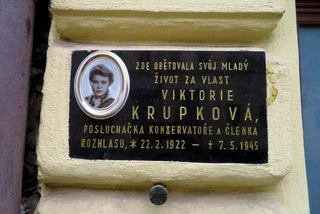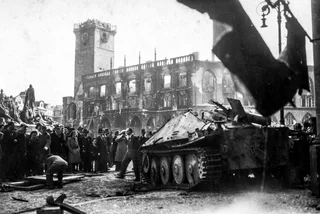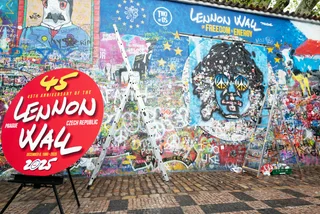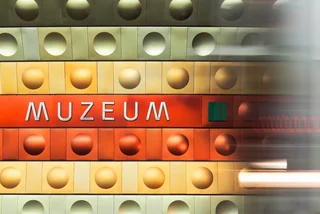When an atom bomb was dropped on Hiroshima, Japan, on Aug. 6, 1945, at the end of World War II, one of the few buildings to survive the blast was the Hiroshima Prefectural Industrial Promotion Hall, designed by Czech architect Jan Letzel. A stone fragment from one of the building’s windows is now on display at the New Building of the National Museum in the 20th Century History exposition.
National Museum director Michal Lukeš and Japanese Ambassador to the Czech Republic Hideo Suzuki were present when the fragment, a part of a window casing, was unveiled as a new permanent addition to the section dedicated to all the victims of World War II.
"Seventy-seven years ago, an atomic weapon was used for the first time and ended the most terrible war in human history. Today, we are placing a fragment from the Industrial Palace in Hiroshima, built by the Czech architect Jan Letzel, in our permanent exhibition on the History of the 20th Century. The exhibit is not only an important historical object but also a very current memento for today," Lukeš said in a press release.

The former Industrial Palace is now called the Atomic Bomb Dome, or the Hiroshima Peace Memorial. It is still preserved in the condition immediately after the explosion. "Its purpose is to remind everyone of the destructiveness of nuclear weapons and it symbolizes the hope of world peace without nuclear weapons," he added.
Jan Hamáček, who at the time was chairman of the lower house of the Czech parliament, received the fragment as a gift in 2015 from Mitsuo Ochi, the rector of Hiroshima University. The fragment, which is not radioactive, was found in one of the rivers that flow through Hiroshima.
Japan was an ally of Germany in World War II and occupied much of Asia. To this day, it is the only country to have faced a nuclear attack during a war. An estimated 140,000 people died in Hiroshima on Aug. 6, 1945, as a result of the explosion. A second bomb was dropped on Nagasaki on Aug. 9, resulting in over 80,000 deaths. Japan surrendered on Aug. 15, 1945.

The Hiroshima Peace Memorial was inscribed on the UNESCO World Heritage List in 1996. “Through the efforts of many people, including those of the city of Hiroshima, it has been preserved in the same state as immediately after the bombing. Not only is it a stark and powerful symbol of the most destructive force ever created by humankind; it also expresses the hope for world peace and the ultimate elimination of all nuclear weapons,” UNESCO said in its inscription.
Architect and builder Jan Letzel, was born in Náchod in 1880. He moved to Japan in 1907 initially to work for the French firm Lalande Architecture in Yokohama, but he started his own company in 1910. He helped to introduce new building techniques and materials to Japan, such as reinforced concrete and steel.
Over the next few years, Letzel designed more than 40 buildings across Japan, including schools, an embassy, offices, and hotels. The Hiroshima Prefectural Industrial Promotion Hall was completed in 1915. Letzel left Japan for the last time in 1923, shortly after a devastating earthquake that destroyed several of his buildings.

In Prague, you can see some of his work in the external metal details on Hotel Evropa on Wenceslas Square. He also designed the Art Nouveau-style Dvorana pavilion in Mšené-lázně in the Ústí nad Labem region.
He died in Prague in 1935 at the age of 45. Another stone fragment from the Hiroshima Peace Memorial is now on his tomb in his hometown of Náchod.












 Reading time: 3 minutes
Reading time: 3 minutes 






































